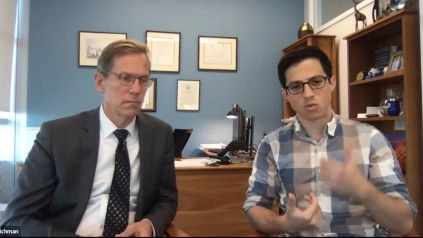Lee P. Richman, MD, Andrew J. Rech, MD and Robert H. Vonderheide, MD of @PennMedicine discuss an algorithm personalizes which cancer mutations are best for immunotherapy.
____________
When tumor cells expand, tens of thousands of genetic mutations are often spawned. It’s like finding a few needles in a haystack to figure out which ones are most important to try with immunotherapy. Now a new model built by researchers at the University of Pennsylvania’s Abramson Cancer Center hand-picks certain needles so they can be leveraged in more effective, personalized cancer vaccines. Cell Systems today published data on the design of the template, and the algorithm is already available online as a resource-serving open source software.
“There are mutations in tumors that can lead to powerful immune responses, but for every one mutation that generates a robust response, about 50 mutations don’t work at all, which means the signal-to-noise ratio is not great,†said the study’s lead author Lee P. Richman, an MD/PhD candidate in Cancer Biology in the Perelman School of Medicine at the University of Pennsylvania. “Our model works like a filter that highlights the signal and shows us which targets to focus on.â€
Actually, the sequencing of a tumor and the detection of potential immunotherapies is based on a calculation called the burden of tumor mutations (TMB), essentially a measure of the frequency of mutations in a given tumor. Tumors with high mutation rates are more likely to respond to inhibitors such as PD-1 targeted immunotherapy. The problem is that as cancer cells divide, they mutate at random, and the possible mutations are almost infinite as they multiply exponentially. This means that while a given immunotherapy may target a certain percentage of cancer cells, it may not be sufficient for any particular patient to be an effective treatment.
Alternatively, the design of the Penn team looks at protein sequences from individual patient samples and determines how much of it looks similar to healthy cells and how much looks different enough to respond to it by the immune system. The more dissimilar it is, the stronger it serves for immunotherapy because it is more likely to attract and activate therapies of healthy cells with less collateral damage. The estimation of the model is also tailored to the test of each person. The group analyzed samples of 318 patients from five different data sets of clinical trials and not only verified the correlation between dissimilarity and promise as a target for immunotherapy, but also noticed that dissimilarity in patients with non-small cell lung cancer associated with increased overall survival after PD-1 therapy.
With so many different possibilities of mutations, we essentially boiled the question of which targets to use down to a math problem, then developed an algorithm to solve it,†said Andrew J. Rech, MD, PhD, a resident in Pathology and Laboratory Medicine and the study’s co-senior author along with Robert H. Vonderheide, MD, DPhil, director of the Abramson Cancer Center. “We also knew it was important to make this model available for other researchers to help inform vaccine development and clinical trials.â€
Future work will also include applying the technique to more data sets to expand the algorithm as well as its use in trials, the researchers say.

